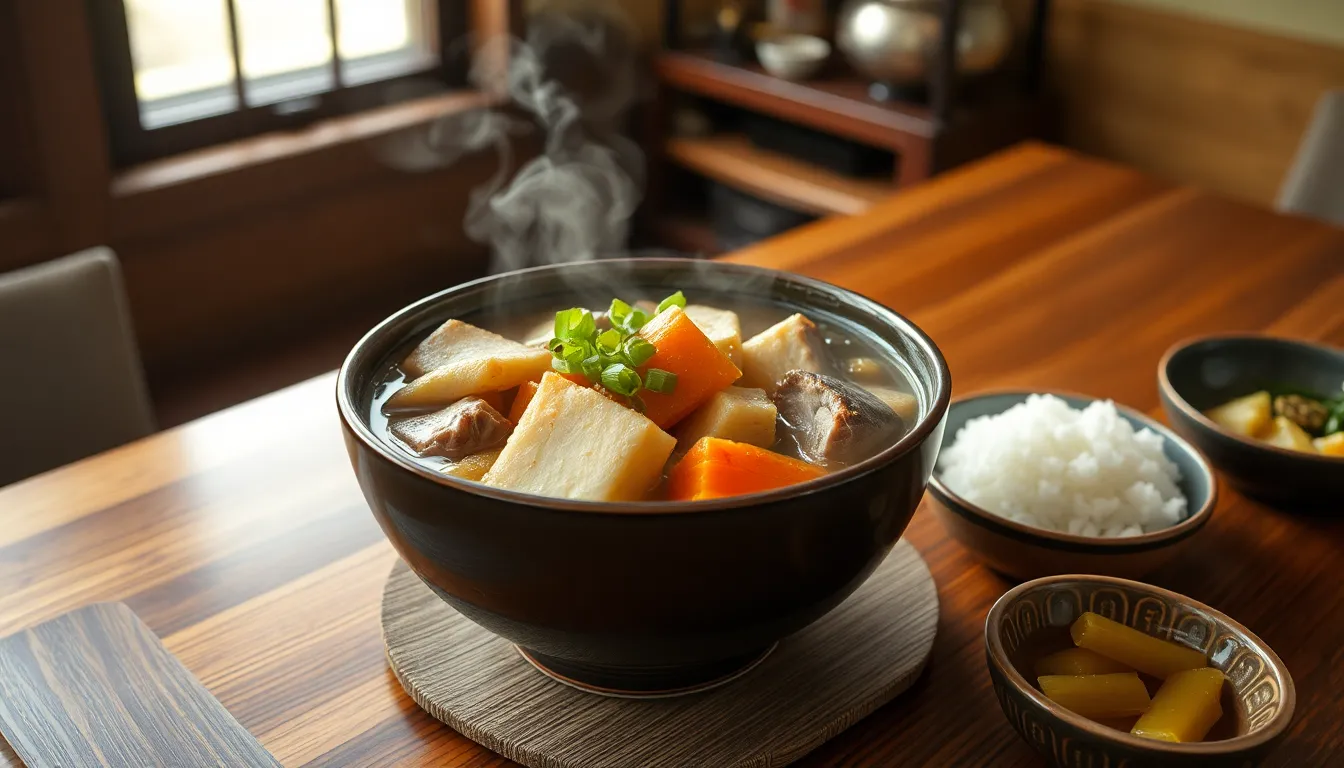
Ever craved a hearty Japanese soup that warms your soul on cold days? Tonjiru, Japan’s beloved pork and vegetable miso soup, delivers comfort in every spoonful with its rich umami flavor and nutritious ingredients.
Looking for the perfect comfort food that’s both nourishing and delicious? Tonjiru (豚汁), also known as butajiru, is a rustic Japanese soup that combines tender pieces of pork with an array of vegetables in a savory miso broth. This soul-warming dish has been a staple in Japanese households for generations, especially during the chilly winter months.
What makes tonjiru special is its incredible depth of flavor from the combination of pork, root vegetables like daikon, carrots, and gobo (burdock root), all simmered in a dashi and miso base. Unlike regular miso soup, tonjiru is heartier and more substantial, making it perfect as a main dish when paired with a bowl of steamed rice. You’ll love how this simple yet satisfying soup brings together traditional Japanese flavors in one comforting bowl.
What Is Tonjiru?
Tonjiru (豚汁) is a hearty Japanese miso soup featuring pork and vegetables. The name combines “ton” (豚) meaning pork and “jiru” (汁) meaning soup. Unlike standard miso soup which typically contains tofu and seaweed Tonjiru incorporates a robust mix of root vegetables and sliced pork creating a substantial meal-worthy dish.
This soul-warming soup stands out for its rich umami flavor profile built upon a foundation of dashi stock enhanced with miso paste. The combination of tender pork slices and chunky vegetables like daikon radish carrots burdock root and konnyaku creates a satisfying texture that distinguishes it from lighter Japanese soups.
Tonjiru holds a special place in Japanese cuisine as comfort food especially during cold winter months. The soup originated as a practical way to create a filling meal using affordable ingredients making it a staple in home cooking throughout Japan. Many Japanese families have their own variation with regional differences influencing vegetable choices and preparation methods.
What makes Tonjiru truly special is its balance of flavors and textures. The earthy sweetness from root vegetables perfectly complements the savory pork while the miso provides depth and complexity. Each spoonful offers a different combination of ingredients creating an ever-changing experience throughout the meal.
Beyond its delicious taste Tonjiru delivers exceptional nutritional value. The diverse vegetable medley provides fiber vitamins and minerals while the pork adds protein making it a well-rounded one-pot meal that sustains energy throughout the day. This practical aspect explains why Tonjiru remains a beloved everyday dish in Japanese households rather than being relegated to special occasions.
Why You’ll Love This Tonjiru Recipe
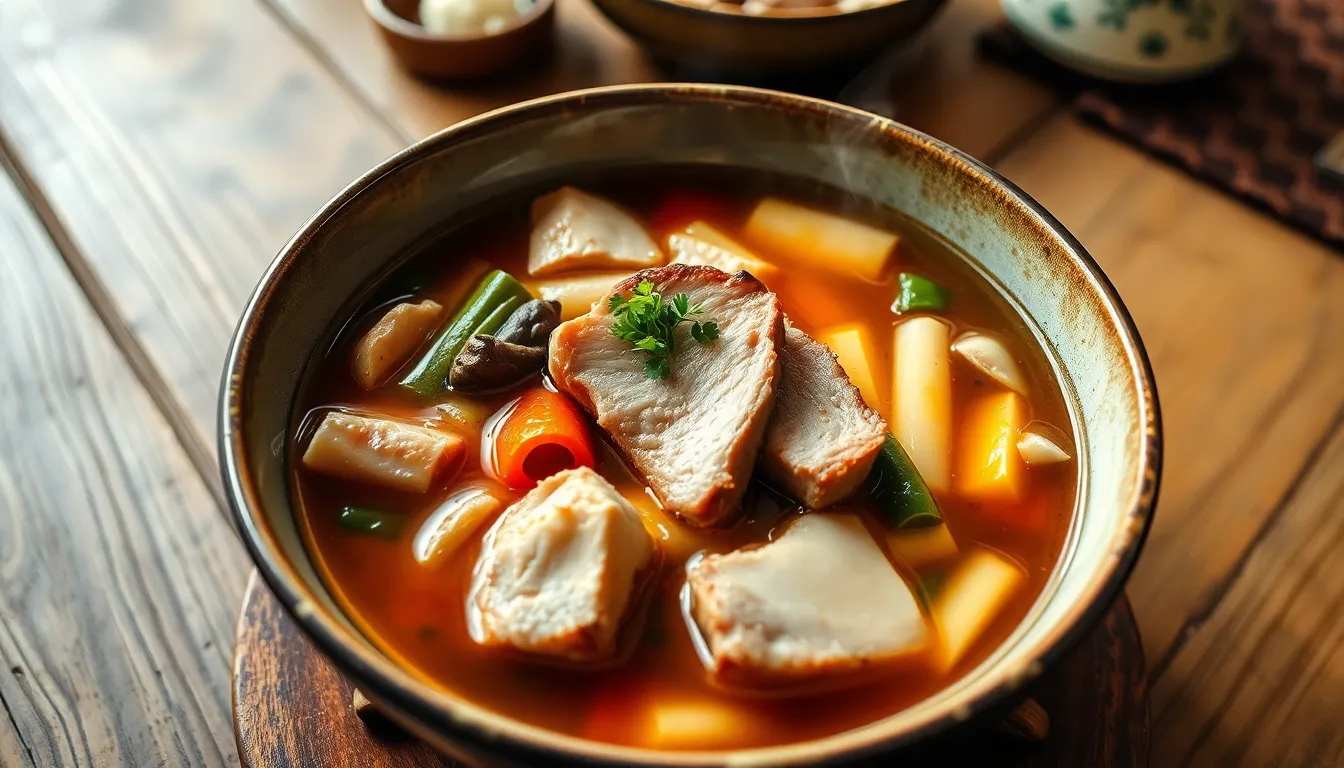
This hearty Japanese pork and vegetable miso soup will quickly become a favorite in your meal rotation. Tonjiru combines perfectly tender slices of pork belly with an assortment of nutrient-packed root vegetables all swimming in a rich umami-filled broth.
The savory depth of this soup comes from stir-frying the meat and vegetables before adding the dashi stock—a technique that significantly enhances the overall flavor profile. Each spoonful delivers a beautiful balance of earthy sweetness from the vegetables alongside the savory notes from the pork.
You’ll appreciate how versatile this recipe is for meal planning. Make a large batch on the weekend to enjoy throughout the week as Tonjiru keeps well for several days with flavors that actually improve over time. This soup pairs wonderfully with Japanese salted salmon, a bowl of steamed rice, and some simple pickles for a complete and satisfying meal.
The combination of gobo (burdock root), daikon radish, carrots, and konnyaku provides not just incredible texture but also makes this soup exceptionally nutritious. These root vegetables contribute essential vitamins and minerals while the pork adds protein, creating a truly nourishing comfort food.
Preparation remains straightforward even though the impressive depth of flavor. The key is adding the miso paste just before serving to preserve its delicate aroma and taste—a simple step that makes a remarkable difference in the final result.
Key Ingredients for Authentic Tonjiru
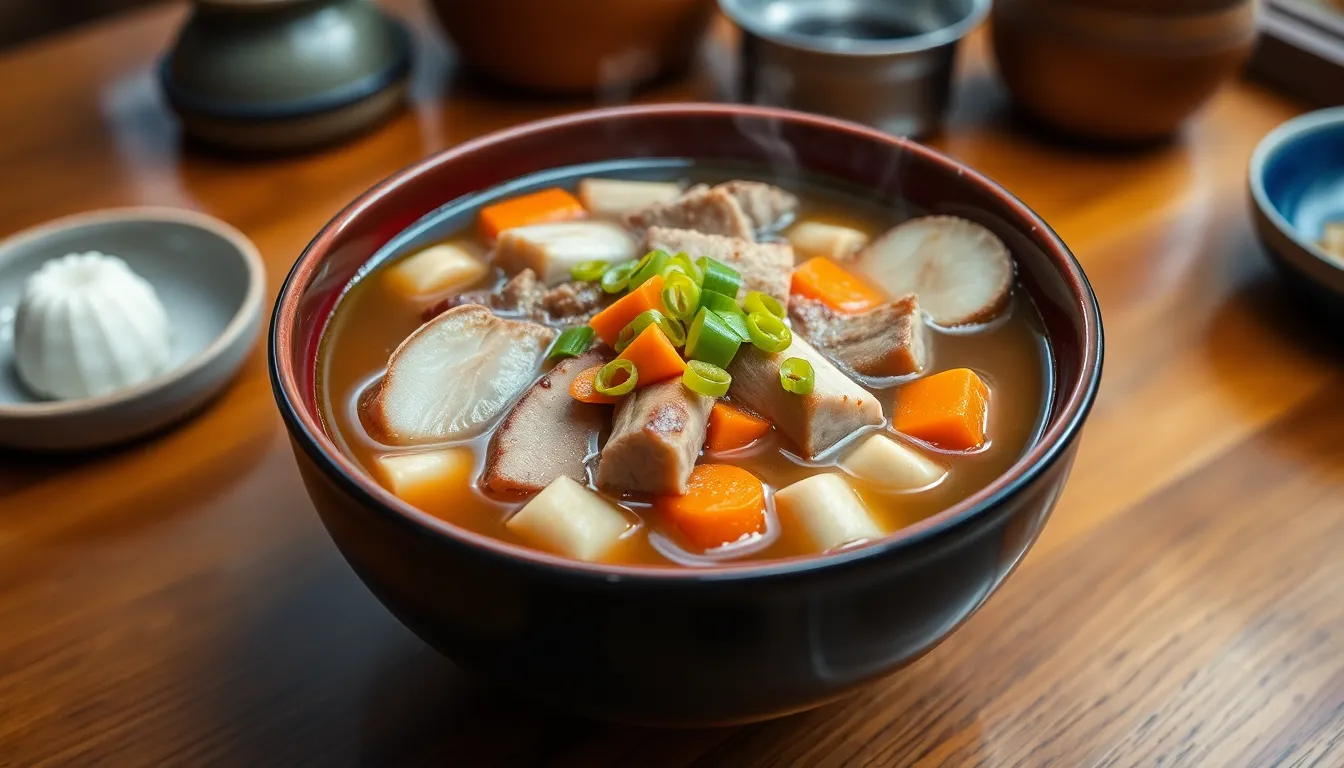
Creating a truly authentic Tonjiru requires exact ingredients that contribute to its distinctive flavor profile and hearty texture. Each component plays a crucial role in developing the rich, comforting character this traditional Japanese soup is known for.
Pork and Vegetables
Sliced pork belly stands as the protein foundation of Tonjiru, prized for its ideal balance of fat and flavor that enriches the broth as it simmers. You can substitute pork loin or pork jowl if belly isn’t available, though the fat content of belly adds important depth to the finished soup. Root vegetables form the backbone of this hearty dish, with essential components including:
- Burdock root (gobo) – brings an earthy flavor and pleasant texture
- Japanese taro (satoimo) – adds creaminess and absorbs the soup’s flavors
- Daikon radish – provides a mild sweetness when cooked
- Carrot – contributes natural sweetness and vibrant color
- Onion – creates aromatic base notes
- Konnyaku (konjac) – offers a unique chewy texture and absorbs flavors well
Many authentic versions also incorporate shiitake mushrooms for umami depth and Japanese leeks (naganegi) for aromatics. You’ll find aburaage (deep-fried tofu pouch) and medium-firm or silken tofu in traditional preparations, adding protein variety and contrasting textures that complement the heartier elements.
Miso and Dashi
Miso paste functions as the soul of Tonjiru, providing the signature umami foundation and complexity that distinguishes this soup. You should add this fermented soybean paste toward the end of cooking to preserve its delicate aromatic qualities. Traditional recipes often introduce miso in two stages—first to build base flavor, then again just before serving to brighten the profile with fresh notes.
Dashi broth creates the essential liquid base that ties all ingredients together. The most authentic version is awase dashi, combining the sea-vegetable depth of kombu (dried kelp) with the smoky fish notes of katsuobushi (bonito flakes). This foundational stock delivers layers of umami that simple water cannot achieve. Vegetarians can substitute shiitake mushroom dashi while maintaining good flavor complexity. When preparing Tonjiru, toasted sesame oil is typically used for initial vegetable sautéing, imparting a nutty aroma that complements the earthiness of the root vegetables and enhances the overall flavor profile.
Equipment Needed
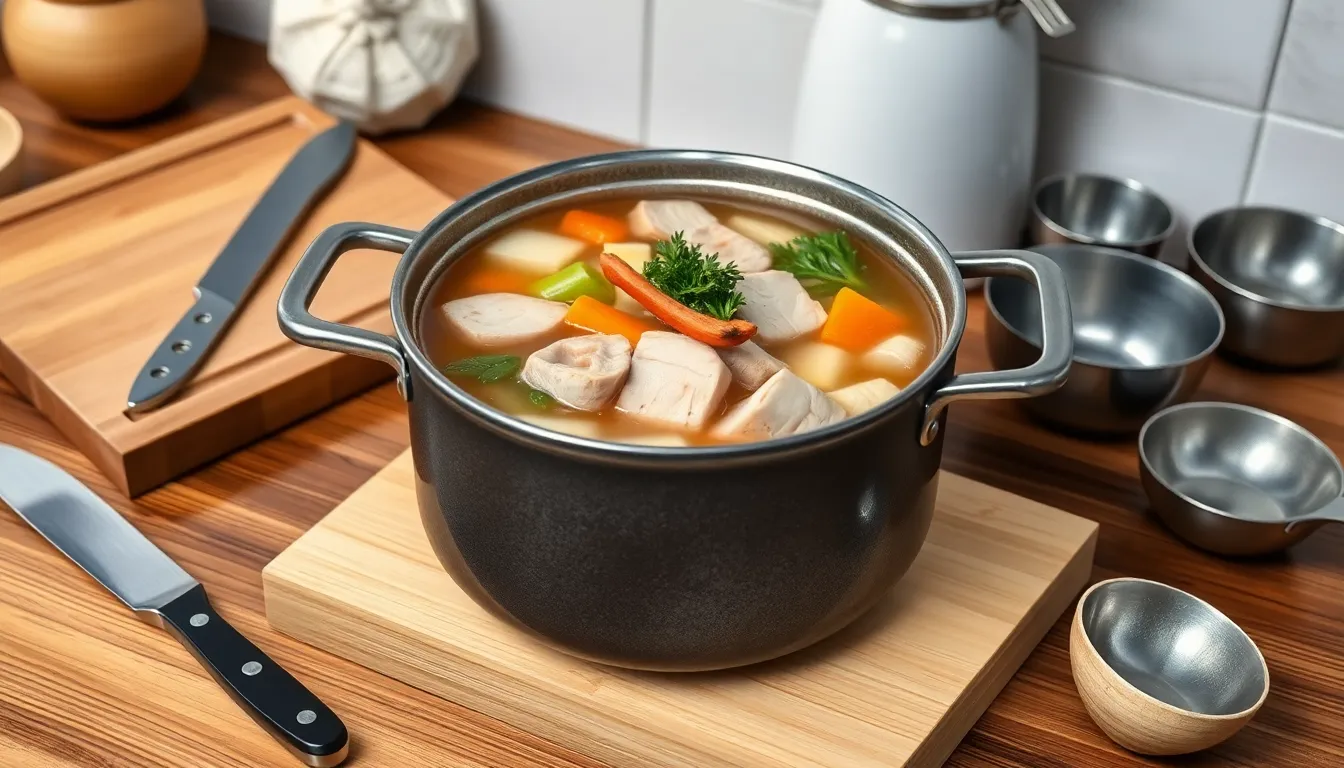
To prepare an authentic Tonjiru at home, you’ll need just a few basic kitchen tools:
- Medium-sized pot – A traditional Yukihira pot works wonderfully, but any medium-sized cooking pot with a heavy bottom will do the job perfectly
- Sharp knife and cutting board – Essential for properly slicing the variety of vegetables and pork into uniform pieces that will cook evenly
- Ladle – For serving the finished soup into bowls while capturing both broth and chunky ingredients
- Measuring cups and spoons – For accurate measurement of ingredients, especially the miso paste which determines the soup’s flavor intensity
- Vegetable peeler – Helpful for preparing daikon, carrots, and burdock root
- Grater – Used for grating fresh ginger to add that subtle warmth and spice to your Tonjiru
- Fine mesh strainer – Optional but useful for achieving a clearer dashi if making it from scratch
- Wooden spoon or spatula – For sautéing the pork and vegetables without damaging your cookware
The beauty of Tonjiru lies in its simplicity – no specialized equipment is needed to create this nourishing Japanese comfort food. Your standard kitchen setup likely contains everything required to make this hearty soup that has warmed Japanese households for generations.
How to Make Tonjiru

Creating this hearty Japanese pork miso soup involves a straightforward process that yields incredible depth of flavor. Follow these step-by-step instructions to prepare an authentic bowl of tonjiru that will warm you from the inside out.
Preparing the Ingredients
Begin by thinly slicing 3-10 oz of pork belly or thin pork slices. This cut provides the perfect balance of meat and fat that gives tonjiru its signature richness. Peel and cut your vegetables into manageable pieces—slice a carrot thinly lengthwise, shave about 6 inches of gobo (burdock root) into thin strips, and cut 2 inches of daikon radish into thin quarters. Cut konnyaku (konjac) into 2-inch thin slices to add texture to your soup. You can also incorporate additional vegetables like taro, onion, and aburaage (deep-fried tofu pouch) for more variety and flavor. Chop green onions into small pieces and set aside for garnish. If using tofu, tear medium-firm tofu into small pieces or cube it to add later in the cooking process.
Making the Soup Base
Heat 1 tablespoon of roasted sesame oil in a medium-sized pot over medium heat. The sesame oil adds a nutty aroma that forms the foundation of your tonjiru. Pour 6 cups of dashi stock into the pot and bring it to a boil. Add your prepared root vegetables—carrot, gobo, daikon, konnyaku—and simmer until they become tender but still maintain some bite. Lower the heat to medium-low before adding the pork pieces. Cook until the meat changes color and is no longer pink, about 3-4 minutes. This method ensures the pork releases its flavor into the broth while remaining tender.
Adding the Miso
Turn the heat to low before incorporating 6 tablespoons of miso paste. Add the miso gradually, dissolving it well in the soup. For best results, use a fine mesh strainer or dissolve the miso in a ladle first before stirring it into the soup. Never boil the soup after adding miso as high heat destroys its delicate flavor compounds and beneficial enzymes. Taste your soup and adjust the seasoning by adding more miso if needed or diluting with additional dashi or water if it’s too salty. This careful addition of miso forms the backbone of authentic tonjiru flavor.
Final Touches
Add your prepared tofu after incorporating the miso. Torn tofu offers more surface area to absorb the rich flavors of the broth. Grate approximately 1 teaspoon of fresh ginger directly into the pot for a bright, aromatic lift that balances the richness of the pork. Sprinkle freshly chopped green onions over the top just before serving. For those who enjoy a bit of heat, add a sprinkle of shichimi togarashi (Japanese seven-spice) to each bowl. When reheating leftover tonjiru, warm it gently on low heat without allowing it to boil to preserve the miso’s integrity. Serve this satisfying soup in miso soup bowls while hot to experience the full spectrum of its comforting flavors and aromas.
Serving Suggestions
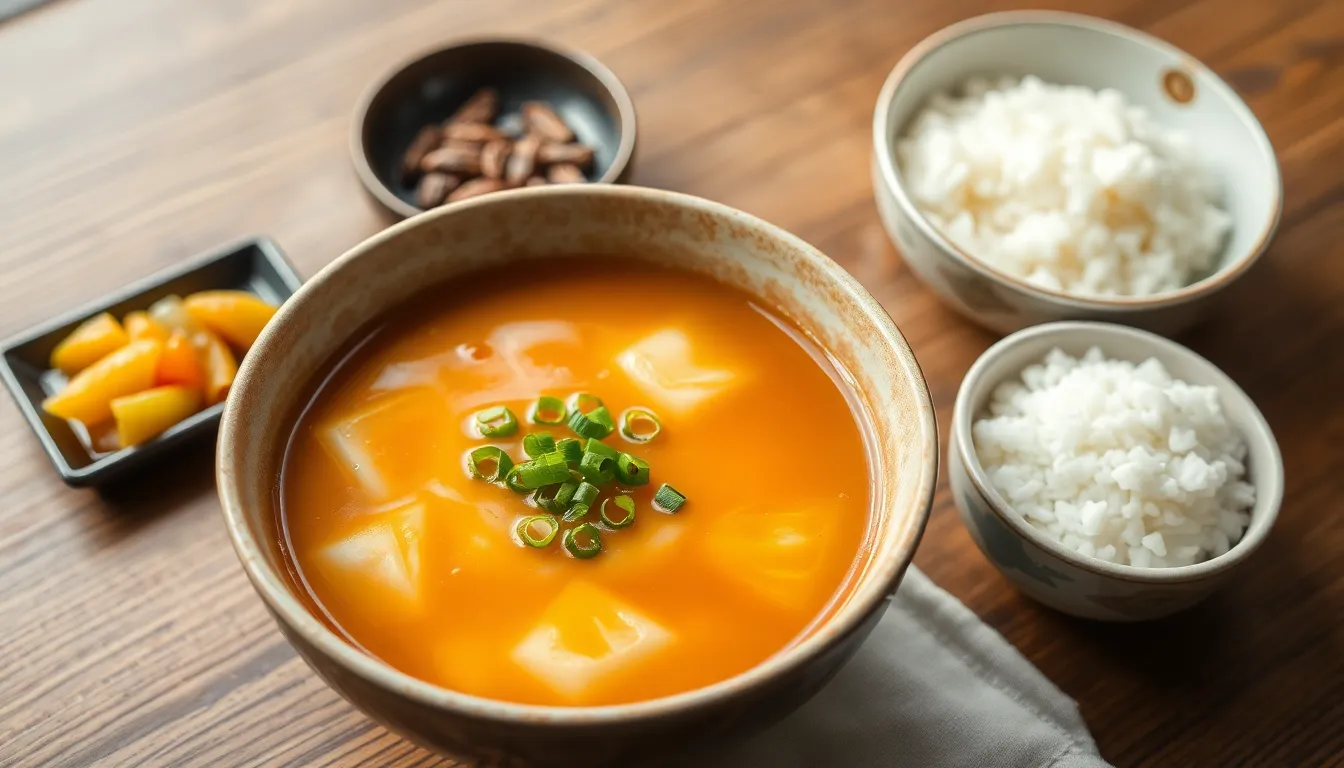
Tonjiru traditionally arrives at the table piping hot as either a main dish or a substantial side depending on your meal planning. For an authentic Japanese dining experience pair this hearty soup with a bowl of steamed white rice which serves as the perfect canvas for soaking up the rich umami flavors.
Create a complete Japanese meal by serving tonjiru alongside:
- Steamed short-grain rice
- Japanese pickles (tsukemono)
- Grilled fish such as salted salmon
- Simple green salad with sesame dressing
The soup’s robust flavor profile allows it to stand on its own during colder months. Many Japanese households enjoy tonjiru as a one-pot meal with just rice and pickles for a satisfying dinner that requires minimal preparation.
When adjusting the flavor balance remember that miso pastes vary significantly in saltiness between brands. Start with a smaller amount and gradually add more to achieve your preferred taste profile. You can also customize the spice level by adjusting the amount of shichimi togarashi sprinkled on top.
For meal prep enthusiasts tonjiru offers excellent make-ahead potential. Store the soup base without miso and simply add this key ingredient fresh when reheating. This technique preserves the delicate flavor compounds in miso that break down with extended cooking or reheating.
Serve your tonjiru in deep ceramic bowls that retain heat well allowing you to enjoy this warming soup from first spoonful to last. Garnish with freshly chopped green onions just before serving to add a bright visual contrast and fresh flavor that complements the rich savory broth.
Storage and Reheating Instructions

Properly storing your Tonjiru ensures you can enjoy this hearty soup for several days after preparation. Allow your freshly made soup to cool completely at room temperature before transferring it to airtight containers for refrigeration. When stored correctly in the refrigerator, Tonjiru remains flavorful and safe to consume for 4 to 5 days.
Unlike many soups, Tonjiru does not freeze well due to the texture changes that occur in the vegetables and the deterioration of miso flavor during the freezing process. The konnyaku, daikon, and other root vegetables tend to become mushy when frozen and thawed, significantly altering the soup’s characteristic texture.
To reheat your Tonjiru, pour the desired portion into a saucepan and warm it gently over medium-low heat. Stir occasionally until the soup reaches a bare simmer but avoid bringing it to a full boil. Boiling miso destroys its delicate flavor compounds and diminishes the soup’s overall taste quality.
For the best flavor when reheating, consider these expert tips:
- Add a small amount of freshly dissolved miso paste to revitalize the flavor profile
- Throw in some freshly chopped green onions as garnish after reheating
- Stir in a dash of sesame oil just before serving to enhance the aromatic qualities
Many Japanese home cooks claim that Tonjiru actually tastes better the next day, as the flavors have time to meld and deepen overnight in the refrigerator. This makes it an excellent make-ahead meal option for busy weeknight dinners or lunch preparations.
Variations of Tonjiru
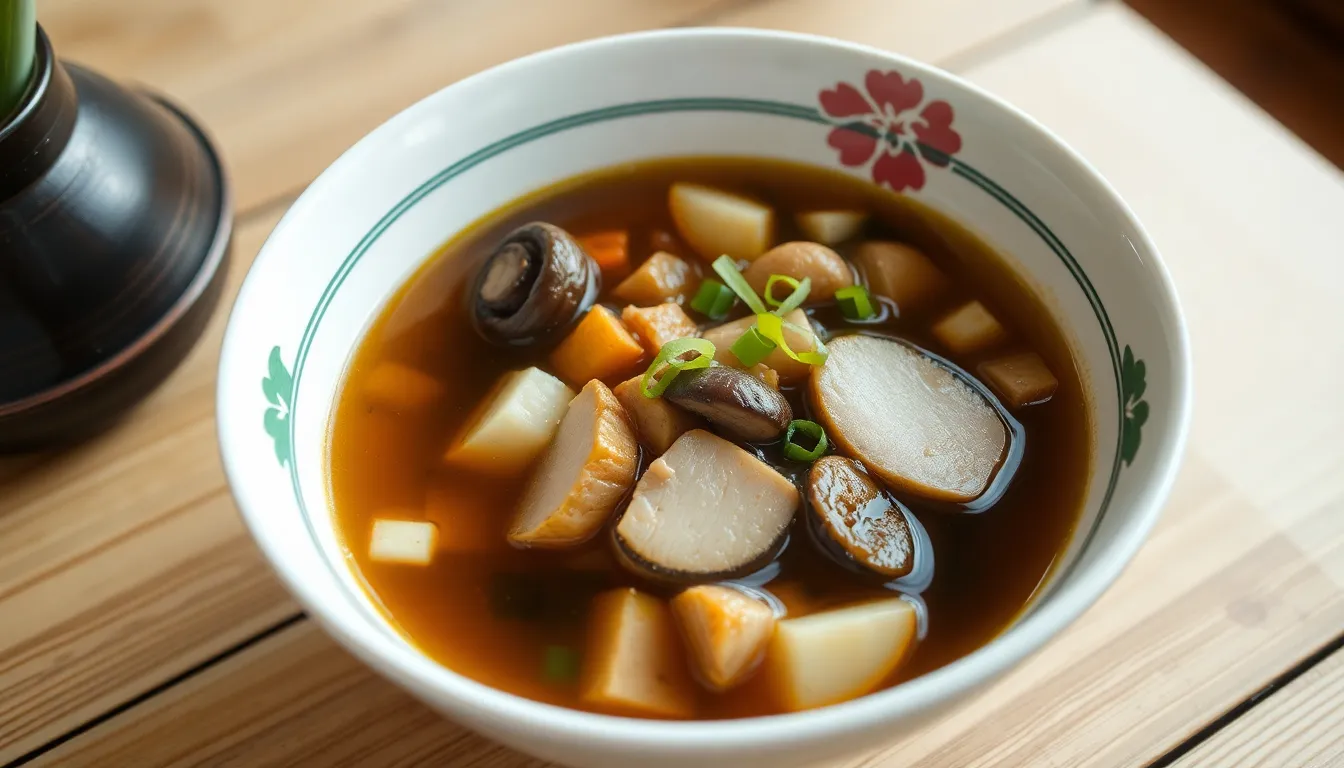
Tonjiru offers endless possibilities for customization based on personal preferences, seasonal availability, and dietary requirements. This versatile soup can be adapted in many ways while maintaining its comforting essence and rich flavor profile.
Regional Differences
Across Japan, Tonjiru recipes vary significantly depending on local ingredients and traditions. Northern regions often incorporate more root vegetables like taro and sweet potatoes to create heartier versions suited for colder climates. In Hokkaido, locals sometimes add butter for extra richness and corn for sweetness. Southern prefectures might include more seasonal greens or local specialties like Kagoshima’s inclusion of sweet potato. The Kanto region tends to favor a balanced flavor with equal parts root vegetables and pork, while Kansai versions often lean toward sweeter miso varieties. Coastal areas incorporate local seafood products into their dashi base, creating a unique umami foundation. These regional adaptations showcase how Tonjiru serves as a canvas for local culinary expression while maintaining its identity as a nourishing pork and vegetable miso soup.
Vegetarian Option
Creating a vegetarian version of Tonjiru requires thoughtful substitutions that maintain the soup’s satisfying texture and depth of flavor. Replace pork with additional firm tofu, aburaage (fried tofu pouches), or plant-based meat alternatives that provide similar texture and protein. Mushrooms serve as excellent meat substitutes, with meaty shiitake, shimeji, or king oyster varieties adding comparable umami depth. Instead of traditional dashi, use kombu dashi or shiitake mushroom stock as your soup base. Increase the amount of burdock root and other vegetables to enhance the hearty nature of the soup. For extra texture, consider adding protein-rich ingredients like edamame beans or cubed tempeh. The miso paste remains a crucial flavor component, though you might want to use a stronger red miso to compensate for the absence of pork fat. This plant-based adaptation delivers the same warming comfort as traditional Tonjiru while accommodating vegetarian dietary preferences.
The Cultural Significance of Tonjiru

Historical Background
Tonjiru emerged during the Meiji era (late 1800s) when Japan began actively promoting meat consumption to improve national nutrition. This hearty soup was designed as an efficient way to feed many people while providing substantial nourishment through the combination of pork and seasonal vegetables. The high fat content from the pork creates a protective layer on the broth’s surface that helps retain heat—making it particularly suited for consumption during Japan’s cold winter months. Unlike many Japanese soups that are light and delicate, Tonjiru was developed to be robust and filling during a time of important cultural change.
Theories of Origin
Several fascinating theories explain how Tonjiru became such an integral part of Japanese cuisine. Satsuma-jiru from Satsuma Prefecture predated widespread meat consumption in Japan and likely influenced Tonjiru’s development as meat became more commonly accepted during the Meiji reforms. The Tondenhei theory suggests that soldiers stationed in Hokkaido created this warming dish to combat the extreme cold during their night camps in Japan’s northernmost island. Many culinary historians also note Tonjiru’s relationship to Kenchin-jiru, a vegetarian Buddhist soup similar in preparation but without meat for religious reasons—Tonjiru essentially represents the meat-inclusive counterpart to this traditional dish.
Culinary Role
Tonjiru occupies a unique position in Japanese food culture, functioning as a versatile dish that can serve as a snack, appetizer, or main meal when paired with rice. The soup’s balanced flavors and straightforward preparation have cemented its status as a staple in home cooking across Japan. Popular media has further elevated Tonjiru’s cultural significance, with the soup featured prominently in shows like Netflix’s “Midnight Diner: Tokyo Stories,” which showcases beloved comfort foods that hold special meaning in Japanese society. This hearty soup transcends simple nourishment to represent the practical ingenuity of Japanese cuisine—transforming humble ingredients into a deeply satisfying dish that connects modern diners to culinary traditions dating back more than a century.
Final Thoughts on This Hearty Japanese Soup
Tonjiru stands as a testament to Japanese culinary wisdom – transforming simple ingredients into something truly remarkable. You’ll find this hearty pork and vegetable miso soup offers more than just nutrition; it provides a genuine taste of Japanese home cooking.
The beauty of tonjiru lies in its adaptability. Whether you follow our traditional recipe or create your own variation with seasonal vegetables you’ll end up with a deeply satisfying meal that improves with time.
As you ladle this steaming soup into bowls garnished with fresh green onions remember you’re participating in a beloved Japanese tradition that spans generations. This isn’t just another recipe – it’s comfort food at its finest combining practicality nutrition and incredible flavor in every spoonful.
Frequently Asked Questions
What is Tonjiru?
Tonjiru is a traditional Japanese pork and vegetable miso soup. It combines “ton” (pork) and “jiru” (soup) to create a hearty, umami-rich dish featuring tender pork belly and various root vegetables like daikon, carrots, and burdock, all simmered in a savory dashi and miso broth. Unlike regular miso soup, Tonjiru is substantial enough to serve as a main dish, especially popular during cold winter months.
What ingredients do I need for authentic Tonjiru?
Authentic Tonjiru requires sliced pork belly, root vegetables (burdock root, daikon, carrots, taro, onion), konnyaku, shiitake mushrooms, Japanese leeks, miso paste (preferably red or mixed), and dashi stock. The combination of these ingredients creates the characteristic rich flavor and hearty texture that distinguishes Tonjiru from regular miso soup. Each ingredient contributes unique textures and flavors to the final dish.
How do I make Tonjiru?
First, prepare ingredients by thinly slicing pork and cutting vegetables into bite-sized pieces. Heat sesame oil in a pot, stir-fry the vegetables briefly, then add dashi stock and bring to a simmer. Add pork and continue simmering until vegetables are tender. Turn off heat and stir in miso paste until dissolved. Garnish with green onions before serving. The key is adding miso at the end to preserve its flavor.
What makes Tonjiru different from regular miso soup?
Tonjiru is heartier and more substantial than regular miso soup. While standard miso soup typically contains tofu and seaweed in a light broth, Tonjiru features pork and various root vegetables, creating a more filling dish. The cooking method also differs, as Tonjiru involves stir-frying ingredients before adding broth, which enhances flavor development. Additionally, Tonjiru often uses red miso for a deeper taste profile.
Can I make Tonjiru vegetarian?
Yes, Tonjiru can be adapted for vegetarians by substituting pork with firm tofu, tempeh, or additional mushrooms like king oyster or shiitake for texture and umami. Use kombu dashi or shiitake dashi instead of bonito-based dashi. The root vegetables remain the same, providing the hearty character of the soup. This version maintains the satisfying texture and flavor profile while accommodating vegetarian diets.
How should I serve Tonjiru?
Serve Tonjiru in deep ceramic bowls garnished with sliced green onions. It pairs perfectly with steamed white rice, Japanese pickles (tsukemono), grilled fish, and a simple green salad for a complete meal. Tonjiru can be enjoyed as a main dish, especially during colder months. Some people enjoy adding a drop of chili oil or yuzu kosho for extra flavor.
How long can I store Tonjiru?
Tonjiru can be refrigerated for 4-5 days in an airtight container. The flavor often improves after a day as ingredients meld together. However, it doesn’t freeze well due to texture changes in the vegetables. When reheating, do so gently over medium-low heat, and consider adding freshly dissolved miso paste to revitalize the flavor. Garnish with fresh green onions before serving.
What are regional variations of Tonjiru?
Regional variations of Tonjiru reflect local ingredients and preferences throughout Japan. Hokkaido versions might include butter and corn, while Kagoshima may incorporate sweet potatoes. Some regions use chicken instead of pork, and coastal areas might add seafood. The type of miso varies by region as well—darker miso in northern regions and lighter miso in southern areas. Each family typically has their own special recipe.
What is the cultural significance of Tonjiru?
Tonjiru emerged during the Meiji era when Japan promoted meat consumption for better nutrition. It represented a practical solution for creating substantial, warming meals during winter using affordable ingredients. The soup draws influences from earlier dishes like Satsuma-jiru and Kenchin-jiru. Today, Tonjiru symbolizes Japanese home cooking and has been featured in popular media like “Midnight Diner: Tokyo Stories,” representing comfort and tradition.
What type of miso is best for Tonjiru?
Red miso (aka miso) or mixed miso (awase miso) works best for Tonjiru as they provide a deeper, richer flavor that complements the heartiness of the soup. Some traditional recipes incorporate miso in two stages—adding some during cooking and the remainder just before serving—to create complexity while preserving the delicate aroma. Regional preferences vary, with northern Japan favoring stronger miso and southern regions using milder varieties.



